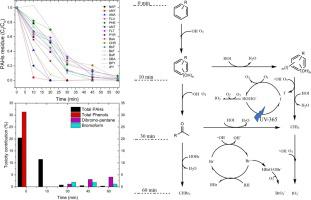Journal of Hazardous Materials ( IF 13.6 ) Pub Date : 2020-07-11 , DOI: 10.1016/j.jhazmat.2020.123456 Bo Liu 1 , Bing Chen 1 , Baiyu Zhang 1 , Xing Song 1 , Ganning Zeng 2 , Kenneth Lee 3

|
Offshore produced water (OPW) containing hazardous substances such as polycyclic aromatic hydrocarbons (PAHs) needs to be treated prior to discharge. This study integrated a photocatalytic ozonation system with TiO2 nanotube arrays (TNA) and UV-light-emitted diode (UV-LED) irradiation and applied to treat OPW. Experimental and modeling efforts were made to evaluate the degradation efficiencies of PAHs, examine the behaviors of the OPW composition (e.g., phenols, iodide, and bromide), and investigate the oxidation intermediates and the associated toxicity and biodegradability. The results indicated that ozone significantly enhanced the oxidation rates and removed the PAHs within 30 min, while the TNA showed strong photocatalytic capability. In the early stage, iodide was a strong ozone competitor, accelerating phenol degradation but inhibiting PAH oxidation, whereas UV-LED fortified the effect. The degradation of aromatics was altered by iodide and bromide at different stages. The contributions of four toxicants to the acute toxicity of OPW were quantified and ranked (PAHs > bromoform > phenols > dibromopentane). The EC50 value increased from 3 % to 57 %, and the biodegradability was doubled with less footprint in 28-day biodegradation tests. Overall, it is recommended to sequentially oxidize the matrix of OPW by ozonation and PAHs by the UV-LED/TNA/ozone system.
中文翻译:

TiO2纳米管阵列与UV-LED辐射耦合对海上采出水进行光催化臭氧氧化。
含有有害物质(例如多环芳烃(PAH))的海上采出水(OPW)需要在排放前进行处理。这项研究将光催化臭氧化系统与TiO 2集成在一起碳纳米管阵列(TNA)和紫外发光二极管(UV-LED)的照射,并用于治疗OPW。进行了实验和建模工作,以评估PAHs的降解效率,检查OPW组合物的行为(例如酚,碘化物和溴化物),并研究氧化中间体以及相关的毒性和生物降解性。结果表明,臭氧显着提高了氧化速率,并在30分钟内去除了PAHs,而TNA则显示出强大的光催化能力。在早期,碘化物是强大的臭氧竞争者,加速了苯酚的降解,但抑制了PAH的氧化,而UV-LED增强了这种作用。碘化物和溴化物在不同阶段改变了芳烃的降解。定量和排序四种毒物对OPW急性毒性的贡献(PAHs>溴仿>酚>二溴戊烷)。欧共体50值从3%增加到57%,并且在28天的生物降解测试中,生物降解性提高了一倍,占地面积更少。总体而言,建议通过UV-LED / TNA /臭氧系统通过臭氧化和PAHs顺序氧化OPW的基质。



























 京公网安备 11010802027423号
京公网安备 11010802027423号